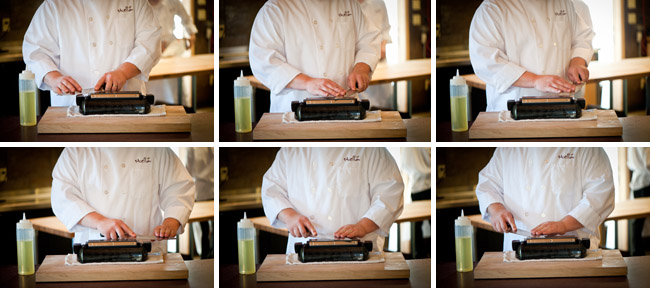When sharpening a German knife, make sure to always use an oil tri-stone unless otherwise instructed by your knife’s manufacturer.
Before starting, wet a kitchen towel, squeeze out the excess moisture, and lay it flat on your work surface. Place the oil-stone on top of the towel. This will help prevent the sharpening stone from slipping during the sharpening process.
You will notice that there are three sides to an oil stone; a course, medium and fine side. You should always start on the coarsest stone and work your way down to the finest.
To start the sharpening process, pour about one to two teaspoons of mineral oil on the course side of the stone. Some people use regular cooking oil, however, I would recommend to always use oil that is manufactured for specific use with oilstones.
Rub the oil all over the stone until it becomes nice and lubricated. At anytime during the sharpening process, if your stone seems to be drying up, add more oil to the stone. You will need to oil each side of the stone throughout the sharpening process.

To begin, place the bottom of your blade at the top end of your “course” stone, at a 22° angle. To find the proper angle, place the blade of you knife directly on top of your stone as if you were going to try and cut the stone in half. This would be a 90° angle. Half that, and you have a 45° angle, and half that to achieve 22.5° angle, which is perfect for German knives.

With one fluid movement, starting from the bolster of the knife, run your blade along the “course” stone, pretending that you’re shaving a thin layer off the top. Notice how the left hand is applying gentle pressure on the tip of the knife (see pictures below). This hand is helping to maintain the angle at which the knife is being sharpened, and is allowing even pressure to be applied to the blade. Repeat this process for 10-30 strokes (depending on how dull your knife is) on one side of the blade, and then repeat the same process on the opposite side.
When sharpening the opposite side of your knife, it’s easiest to switch up your grip. For example, if you were holding the handle of your knife in your right hand, now you will be holding it in your left. If you look at the pictures below, you will see that I have switched up my grip when sharpening the other side of the blade.

Once you have completed the 10-30 strokes on each side of the blade, using the course side of your stone, rotate the stone to the medium gradient, lubricate with oil, and repeat. After 10-30 strokes on both sides of the knife using the medium gradient, flip over the tri-stone to the finest gradient which will be marked “fine.”

Related Resources
There are 7 Comments

Here's the one that I use in
Here's the one that I use in the video. The oil stone shown in the pictures is actually their smaller, 8.5" version which I think is more appropriate for home use. I would recommend reading the reviews and seeing what other people like, but unfortunately a good oil stone is fairly pricey. I've heard stories of cheap oil stones ruining blades, but I've never used one so I can't comment one way or the other.
Chef, For Christmas I
Chef,
For Christmas I finally got a good knife. My wife bought me a 8" Wusthof Classic Hollow Edge Wunder Knife and it is the best knife in the drawer now. For all my knife sharpening needs I use a Spyderco Tri-Angle Sharpmaker and can put a razor edge on just about any knife with it. It takes a lot of the guess-work out of getting that correct 40° angle for your edge (20° on each side) and it uses a medium grit and a fine grit pair of ceramic stones. Would this work to keep that nice sharp edge on my good knife?

@wcatcher, Sorry I'm just
@wcatcher,
Sorry I'm just now seeing this. I've heard good things about that style of sharpener but I haven't used one myself. Sounds like the angle is correct, I'd give it a shot and see how it turns out.
@zubinfisher,
I like to run my knife on the steel for a few swipes before each use (assuming that I'll be using it for more than five minutes). When the blade doesn't seem to be a sharp as I'm used to, I'll run it on the steel again. Once the steel stops bringing back the edge, then I'll take the knife to the sharpening stone.

Hi Juntingang, To answer
Hi Juntingang,
To answer your questions:
- Yes. (I actually prefer waterstones for both Japanese and German Knives).
- Yes. Just sharpen at an extreme angle, about 16 degrees.
